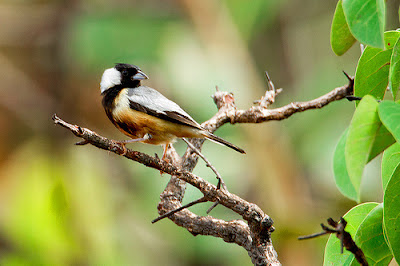A delicate but boldly patterned finch. Long spiny crest usually laid back and crown black, contrasting with white cheeks and ear-coverts.
Face, throat and mid breast, continued over centre of belly black, contrasting with flanks and belly orangey buff. Silvery grey back; black wings and tail with pale wing coverts.
White in base of outer rectrices visible in flight. Female paler with brown tinge above and brown shorter crest.
Greyish face, eyebrow and underparts dull cinnamon buff.
Male unmistakable, and females pattern plus white in tail does not resemble other finches. Voice Song is a modest 3-syllabled phrase. Inconspicuous thin tzip-tzip call.
Hints In pairs or small groups somewhat inconspicuous in the vegetation cover or even on the ground.
Distribution and population:
Charitospiza eucosma occurs in north-east and central Brazil (central Piauí, south Maranhão and south-east Pará south through Goiás, west Bahia and central Minas Gerais to south-east Mato Grosso and central São Paulo), north-east Bolivia (Serranía de Huanchaca in Santa Cruz) and north-east Argentina (single records from Misiones in 1961 and, bizarrely, one recently collected in Tucumán). It can be uncommon to fairly common, but has a very local and erratic occurrence.
If you liked this article, subscribe to the feed by clicking the image below to keep informed about new contents of the blog:























0 comments:
Post a Comment
Do not insert clickable links or your comment will be deleted. Check the Notify me notifications to be notified via email of new comments. If I helped you with the post or with the answers to the comments, share on Facebook or Twitter. Thank you.